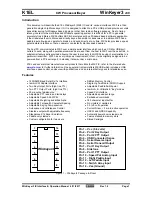
23
LTDVE4CH-20 | INSTRUCTIONS MANUAL
The controller is triggered by camera 1 using one of the four available synchronization inputs.
Camera 2 is triggered by the controller using one of the four available synchronization outputs.
Generally, it is not possible to provide the details of the connections to the cameras because these
are often vendor specific. Please see the camera hardware manual for more information.
14. Operation
There are several ways to configure the controller.
A first option is to use the serial RS485 interface. To support this interface the controller implements
a subset of the Modbus/RTU slave protocol. A second option is to use the Ethernet interface.
Supported Ethernet speeds are 10 Mbit/s and 100 Mbit/s with auto negotiation. The Ethernet
interface allows to configure the controller using the Modbus/TCP slave protocol, the Modbus/UDP
slave protocol or the HTTP protocol. For supporting the latter, the controller provides an internal web
server accessible by most common web
browsers.
In the next sections, an overview of the Modbus/RTU, Modbus/TCP and Modbus/UDP protocols is
given.
14.1. Operation with Modbus
The Modbus/RTU, Modbus/TCP and Modbus/UDP protocols are supported by most programmable
logic controllers (PLCs) with a suitable communication port. The controller can also be configured
by any PC with a proper interface.
Being simple and robust, over the years Modbus became a well-known communication protocol and
it is now a commonly available means of connecting industrial electronic devices. The development
and update of Modbus protocols has been managed by the Modbus Organization since April 2004.
The Modbus Organization is an association of users and suppliers of Modbus compliant devices that
seeks to drive the adoption and evolution of Modbus.
The organization web site is:
More information, including Modbus specifications, implementation guides and code fragments can
be downloaded from:
http://www.modbus.org/specs.php
14.1.1. Comparison of Modbus/RTU, Modbus/TCP and Modbus/UDP
The Modbus/RTU, Modbus/TCP and Modbus/UDP are pretty similar. The main difference is that
Modbus/RTU is used on serial lines, while Modbus/TCP and Modbus/UDP are used on Ethernet
connections. Modbus/TCP is connection-oriented and is implemented using TCP packets, while
Modbus/UDP is connectionless and is implemented using UDP packets.
The controller implements Modbus/RTU with a serial RS485 interface (by default operating at 9600
bits per second, with even parity). The controller implements Modbus/TCP and Modbus/UDP with
an Ethernet interface operating at 10 Mbit/s or 100 Mbit/s with auto negotiation.
14.1.2. Supported function codes
Modbus is a request/reply protocol and offers services specified by function codes.
The controller implements a restricted subset of the Modbus slave protocol. The list in
function codes supported by the controller
summarizes the Modbus function codes supported by the
controller with the current firmware.
















































